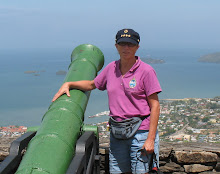We had decided to return to Antigua in the morning. The hazard level 3 meant we were allowed to sail around the south end of Montserrat—strictly verbotten last year. We could go as close to shore as we wanted, but we could not set foot on the land.
We set sail shortly after 6 a.m., about 15 minutes after Nick and Anna. I was very keen to see Plymouth from the water. Then, horrors! As we passed Breackweck Point, a horrendous squall struck. The usual: howling winds, torrential rain. Zero visibility. The island, a couple of hundred feet away, disappeared.
We moved down the coast, closer and closer to Plymouth, as if travelling with our own personal cloud. I begged the sun to come out and clean up this mess. And, bless it, it did. The following are some of my pictures from that coastal run.
Plymouth seen through our "cloud".
Plymouth engulfed.
Plymouth, Montserrat.
Volcanic muck carved away beside Plymouth.
The volcano over Plymouth.
We made good time back to Antigua, which means we were home in time for the tot. A great three days and a wonderful island. I'm glad I drank that water as it means I'll be going back there.
Back in Antigua, it was all about waiting for the mainsail. Nerves were becoming frayed. The sail loft said it hadn't left China yet. Then, miraculously, WW got a tracking number for it, only a couple of days after it had been due. He logged onto the internet regularly to find out where it was.
We had several very pleasant social engagements. Mike and Anne had the Tot Club to dinner one night. WW and I were rum bo'suns January 24 to 29. On Wednesday, January 26, the Tot Club celebrated Burns' Night, a day late, at Life with Sainsbury's haggis, champit tatties, neeps, sundry toasts, too much food and rather a lot of wine.
We rented a car and went up to Crabb's Peninsula to look at the spectacular marina there. WW wants Django pulled for the summer and have her bottom cleaned and redone with antifouling paint before our return next fall. It was a most impressive place set amidst lovely islands suitable for pleasant shore cruises. We may take her there rather than Jolly Harbour.
Our guests, my sister Frisha and her husband Whit arrived on January 29. The sail was in Japan. Then Alaska. Then Louisville, Kentucky. Sunday night, it was in Puerto Rico.
On Sunday, WW and the guests hiked up to Shirley Heights on the Lookout Trail, where they joined me and other totties at Keep Fit. They then had a drink at Shirley Heights before hiking back down via Fort Charlotte, back to Boffo.
Whit and Frisha hiking down to Fort Charlotte.
We rented a car on Monday and went up to St. John's to visit the museum and for lunch on Redcliffe Quay. Then we drove down to Jolly Harbour to provision and show our guests the marina. When we got back to English Harbour...the sail had arrived.
Without wasting a moment, the sail was raised and furled. We organized ourselves and set off for the bay outside Jolly Harbour. Our next cruise had begun.













